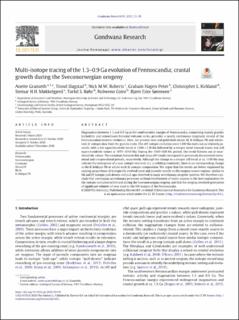| dc.contributor.author | Granseth, Anette | |
| dc.contributor.author | Slagstad, Trond | |
| dc.contributor.author | Roberts, Nick M.W. | |
| dc.contributor.author | Hagen-Peter, Graham | |
| dc.contributor.author | Kirkland, Christopher L. | |
| dc.contributor.author | Møkkelgjerd, Steinar Halvdan Hansen | |
| dc.contributor.author | Røhr, Torkil Sørlie | |
| dc.contributor.author | Coint, Nolwenn | |
| dc.contributor.author | Sørensen, Bjørn Eske | |
| dc.date.accessioned | 2022-04-26T11:48:58Z | |
| dc.date.available | 2022-04-26T11:48:58Z | |
| dc.date.created | 2021-01-08T19:36:48Z | |
| dc.date.issued | 2021 | |
| dc.identifier.citation | Gondwana Research. 2021, 91 31-39. | en_US |
| dc.identifier.issn | 1342-937X | |
| dc.identifier.uri | https://hdl.handle.net/11250/2992827 | |
| dc.description.abstract | Magmatism between 1.3 and 0.9 Ga at the southwestern margin of Fennoscandia, comprising mainly granitic batholiths and subordinate bimodal volcanic rocks, provides a nearly continuous magmatic record of the Fennoscandian tectonic evolution. Here, we present new and published zircon Hf, K-feldspar Pb and whole-rock Sr isotopic data from the granitic rocks. The εHf isotopic evolution since 1300 Ma starts out as relatively juvenile, with a flat superchondritic trend at 1300–1130 Ma followed by a steeper trend towards lower, but still superchondritic values at 1070–1010 Ma. During the 1000–920 Ma period, the trend flattens out at near-chondritic values. The variations between flat and steep εHf trends correspond to previously documented extensional and compressional periods, respectively. Although the change to a steeper εHf trend at ca. 1100 Ma may indicate the emergence of a new isotopic reservoir (i.e. a colliding continent), there is no corresponding change in the K-feldspar Pb or whole-rock Sr isotopic composition. We argue that the trends are better explained by varying proportions of isotopically evolved crust and juvenile mantle in the magma source regions, similar to Nd and Hf isotopic pull-downs and pull-ups observed in many accretionary orogenic systems. We therefore conclude that continuous accretionary processes without involvement of exotic sources is the best explanation for the isotopic evolution before and during the Sveconorwegian orogeny, and that the orogeny involved generation of significant volumes of new crust to the SW margin of the Fennoscandia. | en_US |
| dc.language.iso | eng | en_US |
| dc.publisher | Elsevier | en_US |
| dc.rights | Navngivelse 4.0 Internasjonal | * |
| dc.rights.uri | http://creativecommons.org/licenses/by/4.0/deed.no | * |
| dc.title | Multi-isotope tracing of the 1.3–0.9 Ga evolution of Fennoscandia; crustal growth during the Sveconorwegian orogeny | en_US |
| dc.type | Peer reviewed | en_US |
| dc.type | Journal article | en_US |
| dc.description.version | publishedVersion | en_US |
| dc.source.pagenumber | 31-39 | en_US |
| dc.source.volume | 91 | en_US |
| dc.source.journal | Gondwana Research | en_US |
| dc.identifier.doi | 10.1016/j.gr.2020.10.019 | |
| dc.identifier.cristin | 1868066 | |
| cristin.ispublished | true | |
| cristin.fulltext | preprint | |
| cristin.qualitycode | 1 | |

